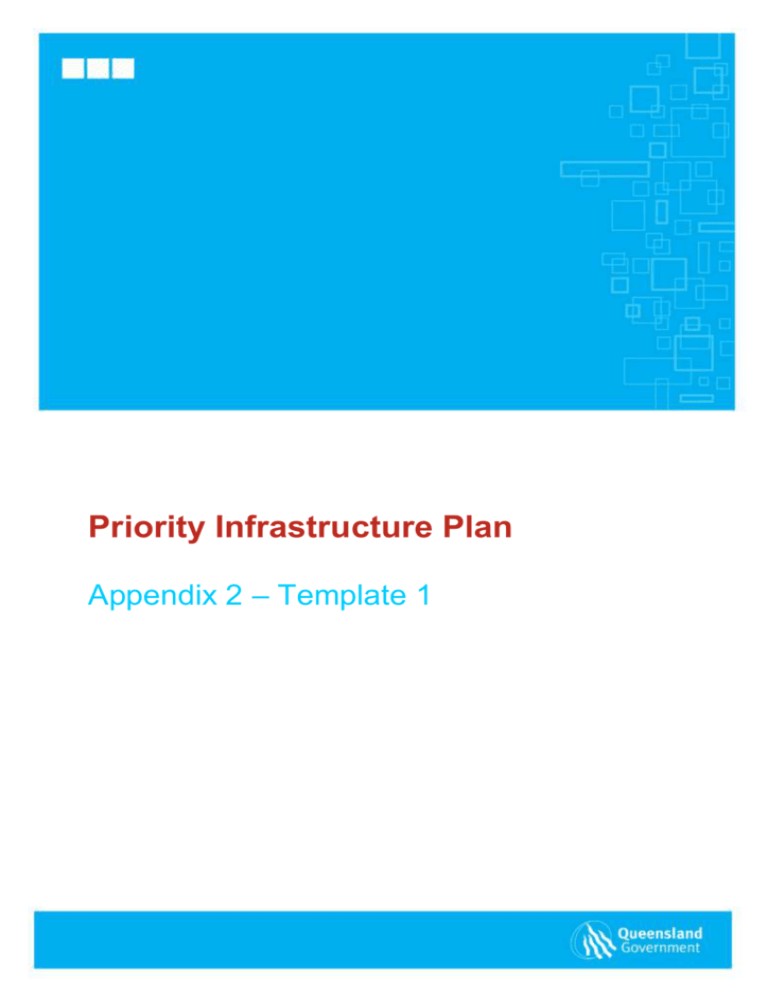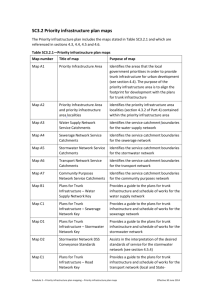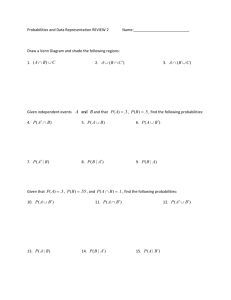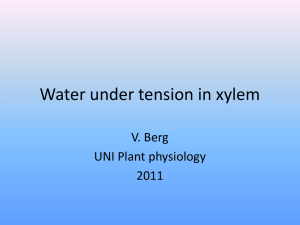Priority Infrastructure Plan Appendix 2 Template 1
advertisement

Priority Infrastructure Plan Appendix 2 – Template 1 0 [Appendix 2] [Template 1] [This template is for use by slower growing local governments that intend to not charge, or adopt a regulated infrastructure charges schedule (RICS) for all or some of their networks.] [Using a RICS is optional. Using a RICS provides local governments with the opportunity to recover infrastructure charges from development. It is each local government’s responsibility to determine how they will balance their funding options.] [If a RICS is not used Section 2 will need to be amended where referring to an infrastructure charge.] [Drafting note: All text shaded in grey is subject to further local government review and amendments where necessary. All text in square brackets offers general drafting guidance and is to be deleted.] Contents 1. Preliminary.............................................................................................................................................. 3 1.1 Introduction ............................................................................................................................... 3 1.2 Purpose .................................................................................................................................... 3 1.3 Structure of priority infrastructure plan ..................................................................................... 3 2. Application of the priority infrastructure plan .......................................................................................... 4 2.1 Applying the priority infrastructure plan to development .......................................................... 4 2.2 Regulated infrastructure charges ............................................................................................. 4 2.3 Supply of necessary trunk infrastructure .................................................................................. 4 2.4 Payment of additional trunk infrastructure costs ...................................................................... 4 2.4.1 Test for inconsistency with assumptions for development inside the PIA ........................ 4 3. Planning assumptions ............................................................................................................................ 5 3.1 Purpose .................................................................................................................................... 5 3.2 Population and housing projections ......................................................................................... 6 3.3 Employment and non-residential floor space projections ........................................................ 7 4. Priority infrastructure area ...................................................................................................................... 8 4.1 Purpose .................................................................................................................................... 8 4.2 The PIA .................................................................................................................................... 8 4.2.1 Determinations of the PIA ................................................................................................. 8 4.2.2 The PIA map ..................................................................................................................... 8 5. Desired standards of service .................................................................................................................. 9 5.1 Water supply network desired standards of service ................................................................ 9 5.2 Sewerage network desired standards of service ................................................................... 10 5.3 Stormwater network desired standards of service ................................................................. 11 5.4 Transport network desired standards of service .................................................................... 12 5.5 Public parks and community land network desired standards of service .............................. 13 6. Plans for trunk infrastructure ................................................................................................................ 16 6.1 Purpose .................................................................................................................................. 16 6.2 Trunk infrastructure networks, systems and elements........................................................... 16 6.3 Plans for trunk infrastructure .................................................................................................. 17 6.4 Trunk infrastructure networks not provided within the PIA..................................................... 17 6.5 Schedule of works .................................................................................................................. 17 7. Extrinsic material .................................................................................................................................. 19 1 Priority Infrastructure Plan: Appendix 2–Template 1 8. Attachment – regulated infrastructure charges schedule ..................................................................... 20 8.1 Purpose .................................................................................................................................. 20 8.2 Regulated infrastructure charges that may be levied ............................................................. 20 8.3 Development subject to infrastructure charges ...................................................................... 20 8.4 Categories of land uses to which RICs apply ........................................................................ 20 8.5 Calculation of regulated infrastructure charges ..................................................................... 21 8.6 Calculation of demand (D) ..................................................................................................... 21 8.7 Calculation of demand credit (DC) ........................................................................................ 22 8.8 Calculation of demand offset (DO) ......................................................................................... 22 8.9 Value of a charge unit ............................................................................................................ 22 8.10 Regulated infrastructure charges subsidies ......................................................................... 23 8.11 Time of payment ................................................................................................................... 23 8.12 Alternatives to paying regulated infrastructure charges ....................................................... 23 2 Priority Infrastructure Plan: Appendix 2–Template 1 Priority infrastructure plan 1. Preliminary 1.1 Introduction This priority infrastructure plan has been prepared in accordance with the requirements of the Sustainable Planning Act 2009. 1.2 Purpose The purpose of the priority infrastructure plan is: (a) to integrate and coordinate land use planning and infrastructure planning (b) to ensure that trunk infrastructure is planned and provided in an efficient and orderly manner (c) to establish an infrastructure funding framework that is equitable and accountable. 1.3 Structure of priority infrastructure plan The priority infrastructure plan: (a) identifies in Section 2 (application of priority infrastructure plan) how the priority infrastructure plan will be applied to development (b) states in Section 3 (planning assumptions) the projections of future urban growth and the assumptions of demand for each trunk infrastructure network, which have informed the preparation of the priority infrastructure plan (c) identifies in Section 4 (priority infrastructure area) the area which will accommodate future urban growth (d) states in Section 5 (desired standards of service) for each network of development infrastructure the desired standard of performance (e) identifies in Section 6 (plans for trunk infrastructure) the existing and planned trunk infrastructure for the following networks: (i) water supply (ii) sewerage (iii) stormwater (iv) transport (v) public parks and land for community facilities. 2. Application of priority infrastructure plan 2.1 Applying the priority infrastructure plan to development The priority infrastructure plan states the basis for: (a) the calculation of regulated infrastructure charges applicable to a development; (b) the imposition of a condition on development requiring: (i) the supply of necessary trunk infrastructure; (ii) the payment of additional trunk infrastructure costs. (c) the imposition by a state infrastructure provider of a condition: (i) about protecting or maintaining the safety or efficiency of the provider's infrastructure network; or (ii) for additional infrastructure costs; or (ii) about protecting or maintaining the safety and efficiency of public passenger transport. 2.2 Regulated infrastructure charges 3 Priority Infrastructure Plan: Appendix 2–Template 1 Regulated infrastructure charges applicable to a development will be calculated in accordance with the regulated infrastructure charges schedule attached to this priority infrastructure plan. 2.3 Supply of necessary trunk infrastructure A condition may be imposed for the supply of necessary trunk infrastructure where: (a) existing trunk infrastructure necessary to service the premises is not adequate and trunk infrastructure adequate to service the premises is identified in the priority infrastructure plan; or (b) trunk infrastructure to service the premises is necessary, but is not yet available and is identified in the priority infrastructure plan; or (c) trunk infrastructure identified in the priority infrastructure plan is located on the premises. The agreed value of the necessary trunk infrastructure supplied for a network will be offset against a regulated infrastructure charge levied for that network for the premises. 2.4 Payment of additional trunk infrastructure costs A condition may be imposed requiring the payment of additional infrastructure costs where: (a) the development: (i) is inconsistent with the assumptions set out in Section 2.4.1; or (ii) is located completely or partly outside the priority infrastructure area; and (b) the development would impose additional trunk infrastructure costs on: (i) the infrastructure provider after taking into account either or both of the following: (1) regulated infrastructure charges for the development; (2) trunk infrastructure supplied or to be supplied by the applicant or; (ii) the state infrastructure provider. 2.4.1 Test for inconsistency with assumptions for development inside the PIA Development is inconsistent with the assumptions if: (a) the type of development was not anticipated to occur in that location based on the planning scheme land uses; or (b) the development results in the total number of dwellings forecasted for the relevant priority infrastructure area (PIA) locality being exceeded in Table 3.1; or (c) the development results in the total amount of non-residential Gross Floor Area (GFA) forecasted for the relevant planning infrastructure area (PIA) locality being exceeded in Table 3.2; or (d) the timing of development is such that trunk infrastructure to service the premises is to be supplied earlier than anticipated in the priority infrastructure plan. [(d) only required if future trunk infrastructure is identified in PFTI and schedules of works] 3. Planning assumptions 3.1 Purpose The planning assumptions summarised in Tables 3.1 and 3.2 outline the projections of residential and non-residential development for the area to which the priority infrastructure plan applies. The assumptions have been developed in accordance with the land use planning provisions of the planning scheme and the anticipated growth in population and employment within the area to which the PIP applies. They form a logical basis for the planning of the networks. Further detailed background information concerning the planning assumptions is referenced in Section 7 (extrinsic material). 4 Priority Infrastructure Plan: Appendix 2–Template 1 3.2 Population and housing projections Table 3.1: Population and housing projections Area Dwelling type Existing and projected population (persons) Average occupancy rate (persons/dwelling) 2006 2006 2011 2016 2021 2011 2016 Existing and projected dwellings 2021 2006 2011 2016 2021 Single dwelling Multiple dwelling Inside PIA Other* Total Single dwelling Outside PIA Multiple dwelling Other* Total Single dwelling Total planning scheme area Multiple dwelling Other* Total * Refers to dwellings such as aged care units and retirement units 3.3 residential floor space projections Table 3.2: Area Employment and non- Employment and non-residential floor space projections Land use and development type Employment (employees) 2006 2011 2016 2021 Average floor space conversion rate (m 2 GFA /employee) Floor space (m 2 GFA) 2006 2011 2016 2021 Commercial Inside PIA Retail 5 Priority Infrastructure Plan: Appendix 2–Template 1 Industry Community Other Total Commercial Retail Outside PIA Industry Community Other Total Commercial Retail Total planning scheme area Industry Community Other Total * Other includes footloose and rural employment 6 Priority Infrastructure Plan: Appendix 2–Template 1 4. Priority infrastructure area 4.1 Purpose The priority infrastructure area (PIA) identifies the area where council plans to provide trunk infrastructure for urban development up to 20__. The PIA is the area where suitable and adequate development infrastructure exists, or where it can be provided most efficiently. 4.2 The PIA 4.2.1 Determination of the PIA [Include explanatory section as required] 4.2.2 The PIA map The PIA is shown on Map:__. 7 Priority Infrastructure Plan: Appendix 2–Template 1 5. Desired standards of service 5.1 Water supply network desired standards of service Measure Reliability/continuity of supply Adequacy of supply Quality of supply Environmental impacts Pressure and leakage management Infrastructure design/planning standards Planning criteria (qualitative standards) All development receives a reliable supply of potable water with minimal interruptions to their service. All development is provided with a water supply that is adequate for the intended use. Provide a uniform water quality in accordance with recognised standards that safeguards community health and is free from objectionable taste and odour. The environmental impacts of the water supply network are minimised in accordance with community expectations. The water supply network is monitored and managed to maintain the reliability and adequacy of supply and to minimise environmental impacts. Design of the water supply network will comply with established codes and standards. Design criteria (quantitative standards) Local government standards in planning scheme and planning scheme policies Customer service standards Customer service obligations Water Service Association of Australia codes IPWEA standards Customer service standards Local government standards in planning scheme and planning scheme policies The Australian Drinking Water Guidelines developed by the National Health and Medical Research Council Compliance with the requirements of the Environmental Protection Act 1994 and associated Environmental Protection Policies and the Water Act 2000 System Leakage Management Plan (Chapter 3, Part 3, Division 1A Water Act 2000) Water Supply Code of Australia—Water Services Association of Australia— WSA 03–2002 The Australian Drinking Water Guidelines developed by the National Health and Medical Research Council Planning Guidelines for Water Supply and Sewerage— Department of Natural Resources and Water (NRW) Local government standards in planning scheme policies 8 Priority Infrastructure Plan: Appendix 2–Template 1 5.2 Sewerage network desired standards of service Measure Reliability Planning criteria (qualitative standards) All development has access to a reliable sewerage collection, conveyance, treatment and disposal system. Quality of treatment Ensures the health of the community and the safe and appropriate level of treatment and disposal of treated effluent. Environmental impacts The environmental impacts of the sewerage network are minimised in accordance with community expectations. Effluent re-use Reuse effluent wherever possible. Infrastructure design / planning standards Design of the sewerage network will comply with established codes and standards. Design criteria (quantitative standards) Local government standards in planning scheme and planning scheme policies Customer service standards Customer service obligations Local water quality guidelines prepared in accordance with the National Water Quality Management Strategy Queensland Water Quality Guidelines 2006— Environmental Protection Agency (where local guidelines do not exist) National Water Quality Guidelines—National Water Quality Management Strategy (where local or regional guidelines do not exist) Compliance with the requirements of the Environmental Protection Act 1994 and associated Environmental Protection policies Guidelines for Sewerage Systems: Reclaimed Water — February 2000 Queensland Water Recycling Guidelines—December 2005 Planning Guidelines for Water Supply and Sewerage—NRW Sewerage Code of Australia— Water Services Association of Australia—WSA 02—2002 Sewerage Pumping Station Code of Australia—Water Services Association of Australia—WSA 04—2005 Local government standards in planning scheme and planning scheme policies 9 Priority Infrastructure Plan: Appendix 2–Template 1 5.3 Stormwater network desired standards of service Measure Quantity Quality Planning criteria (qualitative standards) Collect and convey stormwater in natural and engineered channels, a piped, drainage network and system of overland flow paths to a lawful point of discharge, in a safe manner that minimises the inundation of habitable rooms and protects life. The water quality of urban catchments and waterways is managed to protect and enhance environmental values and pose no health risk to the community. Design criteria (quantitative standards) Queensland Urban Drainage Manual—NRW Local government standards in planning scheme and planning scheme policies Environmental impacts Infrastructure design/planning standards Adopt water-sensitive urban design principles and on-site water quality management to achieve EPA water quality objectives. Design of the stormwater network will comply with established codes and standards. Local water quality guidelines prepared in accordance with the National Water Quality Management Strategy Queensland Water Quality Guidelines 2006— Environmental Protection Agency (EPA) (where local guidelines do not exist) National Water Quality Guidelines—National Water Quality Management Strategy (where local or regional guidelines do not exist) Section 42 Environmental Protection [Water] Policy 1997) Local Government standards in planning scheme and planning scheme policies Queensland Urban Drainage Manual—NRW Local government standards in planning scheme and planning scheme policies Natural Channel Design Guidelines 10 Priority Infrastructure Plan: Appendix 2–Template 1 5.4 Transport network desired standards of service Measure Road network design/planning standards Planning criteria (qualitative standards) The road network provides a functional urban and rural hierarchy that supports settlement patterns, commercial and economic activities, and freight movement. Design of the road system will comply with established codes and standards. Public transport design/planning standards New urban development is designed to achieve safe and convenient walking distance to existing or potential bus stops, or existing or proposed demandresponsive public transport routes. Cycleway and pathway design/planning standards Cycleways and pathways provide a safe and convenient network that encourages walking and cycling as acceptable alternatives. Design of the network will comply with established codes and standards. Design criteria (quantitative standards) Local government road design and development manual/standards/codes in planning scheme and planning scheme policy Road Planning and Design Manual developed by the Department of Transport and Main Roads Australian Standards AUSTROADS guides Local government design and development manual/standards/codes in planning scheme and planning scheme policy Design accords with the performance criteria set by Department of Transport and Main Roads AUSTROADS guides for road-based public transport and high-occupancy vehicles Local government road design and development manual/standards/codes in planning scheme and planning scheme policy Australian Standards AUSTROADS Guide to Traffic Engineering Practice—Part 14 (Chapter 10) Queensland Streets Manual 11 Priority Infrastructure Plan: Appendix 2–Template 1 5.5 Public parks and land for community facilities network desired standards of service Measure Planning criteria (qualitative standards) A network of parks and community land is established to provide for the full range of recreational and sporting activities and pursuits. Functional network Accessibility Land quality/suitability Area/1000 persons Minimum size Maximum grade Flood immunity Facilities/embellishments Infrastructure design / performance standards Public parks will be located to ensure adequate pedestrian, cycle and vehicle access. Public parks will be provided to a standard that supports a diverse range of recreational, sporting and health–promoting activities to meet community expectations. This includes ensuring land is of an appropriate size, configuration and slope, and has an acceptable level of flood immunity. Public parks contain a range of embellishments to complement the type and purpose of the park. Maximise opportunities to colocate recreational parks in proximity to other community infrastructure, transport hubs and valued environmental and cultural assets. Design criteria (quantitative standards) Parks and community land is provided at a local, district and LGA-wide level Parks and community land addresses the needs of both recreation and sport Accessibility standards are identified in Table 5.6.2 The rate of public park provision is identified in Table 5.6.1. The size for public parks is identified in Table 5.6.3. The maximum gradient for public parks is identified in Table 5.6.4. The minimum flood immunity for public parks is identified in Table 5.6.5 Standard embellishments for each type of park are identified in Table 5.6.6 Local government standards in planning scheme and planning scheme policies Australian Standards Table 5.6.1 Rate of land provision Rate of provision (Ha/1000 people) Infrastructure type Local District Local government–wide Recreation park Sport park Community land Table 5.6.2 Accessibility standard Accessibility standard (km) Infrastructure type Local District Local government–wide Recreation park Sport park Community land 12 Priority Infrastructure Plan: Appendix 2–Template 1 Table 5.6.3 Size of parks and community land Minimum size (Ha) Infrastructure type Local District Local government–wide District Local government–wide Recreation park Sport park Community land Table 5.6.4 Maximum desired grade Maximum gradient Infrastructure type Local Recreation park Sport park Community land Table 5.6.5 Minimum desired flood immunity for parks Minimum flood immunity (%) Infrastructure type Local District Flood immunity >Q5 >Q50 >Q100 >Q5 Local government–wide >Q50 >Q100 >Q5 >Q50 >Q100 Recreation park Sport park Community land Table 5.6.6 Standard facilities/embellishments for parks Recreation parks Embellishment type Local Internal roads District Sport parks Local government– wide District Local government– wide [] Parking Fencing/bollards Lighting Toilet Paths (pedestrian/cycle) Seating 13 Priority Infrastructure Plan: Appendix 2–Template 1 Shade structures Covered seatings and table Tap/bubbler BBQ Bins Landscaping (including earthworks, irrigation and revegetation) Signage Activity areas [Cells need only be checked—details of costs are included in the schedules of works.] 6. Plans for trunk infrastructure 6.1 Purpose The plans for trunk infrastructure (PFTI) identify the existing and proposed trunk infrastructure networks intended to service urban development. 6.2 Trunk infrastructure networks, systems and items Table 6.1 defines the trunk infrastructure networks, systems and items covered by the priority infrastructure plan. Table 6.1 Network Water Trunk infrastructure networks, systems and items System Items Bulk supply Water sources (dams, groundwater, bulk supply mains) Raw water mains Water treatment plants (including recycled water treatment plants) Associated monitoring systems Distribution Sewerage Reticulation Sewerage treatment Reservoirs Pump stations Rechlorination facilities Distribution mains generally ≥ 225 mm diameter Associated monitoring systems Pump stations Rising mains generally ≥ 225 mm diameter Gravity sewers generally ≥ 300 mm diameter Odour and corrosion control systems Associated monitoring systems Sewerage treatment plants Storage facilities Release systems Associated monitoring systems 14 Priority Infrastructure Plan: Appendix 2–Template 1 Network Transport Stormwater management System Local government and state controlled roads Items Arterial, sub-arterial and major collector roads including associated intersections, local road drainage, kerb and channel, swales, culverts, bridges, and pathways within the road reserve Public transport Bus stops and shelters Off-road pathways Cycleways and pedestrian pathways not within the road reserve, including associated culverts and bridges Quantity Natural waterways Overland flow paths/channels (natural and constructed) Piped drainage (including pipes, culverts, manholes, inlets and outlets) Detention and retention facilities Stormwater Quality Infrastructure Devices (SQIDs) Gross Pollutant Traps (GPTs) Wetlands Riparian corridors Bio-retention facilities Bank stabilisation, erosion protection and revegetation Quality Public parks and land for community facilities 6.3 Public parks Land, works and embellishments for local, district and local government–wide parks. Land for community facilities Land and basic works associated with the clearing of land and connection to services only Plans for trunk infrastructure Plans identifying the existing and future trunk infrastructure for each infrastructure network are shown on the following maps: Map 1—Plans for water supply trunk infrastructure Map 2—Plans for sewerage trunk infrastructure Map 3—Plans for stormwater trunk infrastructure Map 4—Plans for transport trunk infrastructure Map 5—Plans for public parks and land for community facilities trunk infrastructure. 6.4 Trunk infrastructure networks not provided within the PIA No planning commitment is made to service all premises within the PIA with all networks of trunk infrastructure. Those areas within which certain trunk infrastructure will not be provided are shown on Map/Table_____. [This optional section will only be used if a local government can justify the inclusion of areas within the PIA that are not serviced by all trunk infrastructure networks.] 6.5 Schedule of works Tables 6.2 to 6.6 provide details of future trunk infrastructure for each network. [This section is only required if future trunk infrastructure is identified in the PFTI.] Table 6.2 Schedule of works—water supply network Map Item Future infrastructure asset description no. ID Estimated year of completion Estimated cost ($) 15 Priority Infrastructure Plan: Appendix 2–Template 1 Total estimated cost Table 6.3 Schedule of works—sewerage network Map Item Future infrastructure asset description no. ID Estimated year of completion Estimated cost ($) Estimated year of completion Estimated cost ($) Estimated year of completion Estimated cost ($) Total estimated cost Table 6.4 Schedule of works—stormwater network Map Item Future infrastructure asset description no. ID Total estimated cost Table 6.5 Schedule of works—transport network Map Item Future infrastructure asset description no. ID Total estimated cost Table 6.6 Schedule of works—public parks and land for community facilities network Map Item Future infrastructure asset description Estimated year of Estimated cost no. ID completion ($) Total estimated cost 7. Extrinsic material 16 Priority Infrastructure Plan: Appendix 2–Template 1 The following material provides detailed background information relevant to the preparation of this priority infrastructure plan. Copies of this material are available for viewing. [List all extrinsic material.] 17 Priority Infrastructure Plan: Appendix 2–Template 1 8. Attachment—regulated infrastructure charges schedule [This attachment is for local government information only. The RICS is not mandatory or part of a planning scheme and is therefore not subject to the ordinary amendment procedures of the SPA Statutory Guideline 2/09. Refer to section 641 of SPA 2009.] 8.1 Purpose This schedule has been prepared in accordance with the requirements of the Sustainable Planning Act 2009 and the Sustainable Planning Regulation 2009. It applies to the planning scheme area of the ____________ Planning Scheme. The purpose of the regulated infrastructure charges schedule (RICS) is to enable the establishment costs of trunk infrastructure identified in the priority infrastructure plan to be recovered. This will be achieved through the levying of regulated infrastructure charges on development. 8.2 Regulated infrastructure charges that may be levied Regulated infrastructure charges may be levied for the following trunk infrastructure networks: (a) water supply (b) sewerage (c) stormwater (d) transport (e) public parks and land for community facilities. 8.3 Development subject to infrastructure charges The types of development that may trigger the levying of regulated infrastructure charges are: (a) reconfiguring a lot (b) a material change of use of premises (c) carrying out building work. A regulated infrastructure charge (RIC) may only be levied for development that could reasonably be expected to create or add to demand on the infrastructure network for which the charge is levied. 8.4 Categories of land uses to which regulated infrastructure charges apply The relationship between the planning scheme use types and the classes of land use to which regulated infrastructure charges apply is shown in Table 8.1. Table 8.1 Planning scheme use types to which regulated infrastructure charge rates apply Planning scheme use type Classes of land use to which regulated infrastructure charges rates apply [List relevant planning scheme use types] Residential (single dwelling units) Residential (multiple dwelling units) Commercial Retail Industrial 8.5 Calculation of regulated infrastructure charges A regulated infrastructure charge levied for a trunk infrastructure network is to be calculated in accordance with the following formula: RIC = [(D – DC – DO) x CU] 18 Priority Infrastructure Plan: Appendix 2–Template 1 Where: 1. RIC is a regulated infrastructure charge ($) for the relevant trunk infrastructure network 2. D is the demand for the relevant trunk infrastructure network specified in number of charge units and calculated in accordance with Section 8.6 3. DC is the demand credit for the relevant trunk infrastructure network specified in number of charge units and calculated in accordance with Section 8.7 4. DO is the demand offset for the relevant trunk infrastructure network specified in number of charge units and calculated in accordance with Section 8.8 5. CU is the value of a charge unit ($/ charge unit) specified in Table 8.3. 8.6 Calculation of demand (D) The demand for a trunk infrastructure network is to be calculated by determining the number of charge units applicable to that development using Table 8.2. Purpose for which a charge rate may apply Reconfiguring a residential, commercial, retail, or industrial lot Material change of use or building work for single dwelling unit Material change of use or building work for multiple dwelling units Material change of use or building work for commercial uses Material change of use or building work for retail uses Material change of use or building work for industrial uses Table 8.2 Trunk infrastructure networks Water supply 1 charge unit per additional lot Sewerage Transport 1 charge unit per additional lot Stormwater management 1 charge unit per additional lot 1 charge unit per dwelling 1 charge unit per dwelling 1 charge unit per dwelling 1 charge unit per dwelling 1 charge unit per dwelling 0.75 charge unit per dwelling 0.75 charge unit per dwelling 0.8 charge unit per dwelling 0.5 charge unit per dwelling 10 charge units per hectare of site area 10 charge units per hectare of site area 1 charge unit times (0.7 of site area divided by 400m2) 1 charge unit per 400m2 of site area 1 charge unit per 100m2 of GFA 0.3 charge unit per 100m2 of GFA 10 charge units per hectare of site area 10 charge units per hectare of site area 10 charge units per hectare of site area 10 charge units per hectare of site area 1 charge unit per 400m2 of site area 0.4 charge unit per 100m2 of GFA 1 charge unit per 100m2 of GFA 0.3 charge unit per 100m2 of GFA 1 charge unit times (0.9 of site area divided by 400m2) Trunk infrastructure network demand rates 1 charge unit per additional lot Public parks and community land 1 charge unit per additional lot 1 charge unit per hectare of site area 19 Priority Infrastructure Plan: Appendix 2–Template 1 8.7 Calculation of demand credit (DC) (a) The demand credit is to be calculated using the greater of: (i) the actual amount of demand generated by an existing lawful use of the premises, calculated using Table 8.2; or (ii) the demand for which infrastructure contributions for trunk infrastructure have been previously made. (b) Where a contribution referred to in Section 8.7 (a)(ii) is not expressed in the same demand units as those specified in Table 8.2, the contribution is to be converted into a demand credit as follows: (i) determine the number of demand units for which the previous payment was made (e.g. number of equivalent tenements, equivalent persons, trip ends) (ii) convert the number of demand units calculated in (i) into the equivalent number of charge units for that network. Conversion will be made on the basis that one charge unit within Table 8.2 is equivalent to the demand arising from a single dwelling (one equivalent tenement). (c) A demand credit arising from Clause 8.7(a)(i) will only be provided to a maximum amount equal to the demand arising from a proposed development. 8.8 Calculation of demand offset (DO) (a) The demand offset is to be calculated by converting a contribution for the supply of trunk infrastructure into a demand offset as follows: (i) determine the estimated cost of the infrastructure item identified in the priority infrastructure plan. Where the trunk infrastructure is not identified in the priority infrastructure plan, the value of the infrastructure item shall be agreed. (ii) convert the agreed value of the infrastructure item into number of charge units by dividing the value of the item by the value of a charge unit for that network specified in Table 8.3. (b) Where the demand offset (DO) for a network is greater than the demand (D) for the same network, the infrastructure provider will enter into an agreement to refund the proportion of the establishment cost of the trunk infrastructure that reasonably can be apportioned to other premises. 8.9 Value of a charge unit The value of a charge unit is the amount specified in Table 8.3 for each trunk infrastructure network. Table 8.3 Value of a charge unit Network Water supply Sewerage Stormwater management Transport Public parks and land for community facilities 8.10 Value of a charge unit ($) $ $ $ $ $ Regulated infrastructure charges subsidies Subsidies may be considered for particular premises, uses or qualifying not-for-profit community groups. 20 Priority Infrastructure Plan: Appendix 2–Template 1 8.11 Time of payment A regulated infrastructure charge is payable in any one of the following situations: (a) if the charge applies to reconfiguring a lot—before the local government approves the plan of subdivision (b) if the charge applies to material change of use—before the change of use happens (c) if the charge applies to building work—before the certificate of classification for the building work is issued (d) if paragraphs (a), (b) and (c) do not apply, the day stated in the infrastructure charges notice. 8.12 Alternatives to paying regulated infrastructure charges (a) The local government may enter into an infrastructure agreement involving a contribution in a form other than a regulated infrastructure charge. (b) In respect of trunk infrastructure that is land, a notice may be given in addition to or instead of a regulated infrastructure charges notice requiring the land be given to the local government in fee simple. 21 Priority Infrastructure Plan: Appendix 2–Template 1






